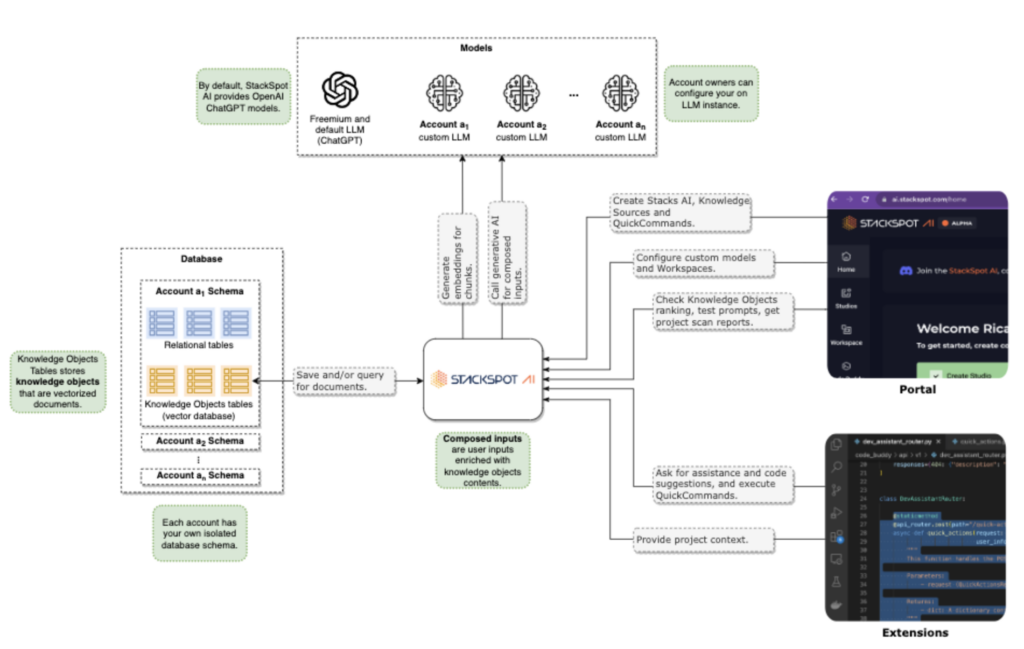In the evolving landscape of artificial intelligence and its integration into various industries, the software development domain remains at the forefront of innovation. Developers today are more empowered than ever, with many tools and platforms at their disposal. However, with power comes complexity, and as software projects grow intricate, the necessity for accurate and efficient coding assistance becomes evident. This blog post will explore StackSpot AI’s architecture and how it can offer hyper-contextualized AI code generation.
While groundbreaking in many respects, general-purpose AI assistants have a limitation: they often provide generic or inaccurate responses, especially when faced with domain-specific queries. A developer seeking advice on optimizing a database query or understanding the intricacies of a particular algorithm might find generic AI tools lacking in depth or precision. Enter StackSpot AI, a platform designed to bridge this very gap.
StackSpot AI is not just another coding assistant. It’s a system meticulously crafted to provide contextualized coding AI assistance, tailoring its interactions based on the unique needs of each developer and project.
Curious to learn more about StackSpot AI’s architecture? Good Read.
StackSpot AI and the RAG mechanism
StackSpot AI stands distinctively apart in the crowded arena of coding assistants. Expertly engineered, it is poised to deliver highly contextualized coding AI assistance, adapting dynamically to the nuanced requirements of individual developers and the context of specific projects. This tailored approach hinges on implementing the RAG mechanism — a two-pronged structure consisting of ‘retrieval’ and ‘generation’ components.
The ‘retrieval’ facet of RAG is adeptly handled by StackSpot AI’s integration with a vector database. Consider, for instance, a developer grappling with optimizing a particularly complex SQL query. Traditional databases might falter in efficiently retrieving relevant solutions. But StackSpot AI, leveraging the power of vector databases, can swiftly identify and present solutions by harnessing the database’s similarity search capabilities. It’s akin to having a seasoned developer peer over your shoulder, pointing you swiftly to pertinent solutions based on the context of your problem.
On the flip side, the ‘generation’ component harnesses the prowess of OpenAI’s state-of-the-art model, GPT-4. Imagine a scenario where a developer is conceptualizing a new algorithm but needs help with its implementation. StackSpot AI, channeling the generative capabilities of GPT-4, can aid in crafting code snippets or offering implementation insights, all tailored to the developer’s specific context.
StackSpot AI combines advanced retrieval with generative capabilities, ensuring developers receive precise, contextual, and timely assistance.
StackSpot AI’s architecture summary
The figure below summarizes StackSpot AI’s software architecture.

StackSpot AI Models
At the heart of StackSpot AI’s architecture are its Models (box at the top of the figure). While the platform comes equipped with the power of OpenAI’s ChatGPT models by default, it recognizes that one size doesn’t fit all. Thus, account owners can configure their bespoke Language Learning Model (LLM) instances, allowing for a personalized touch to the AI-driven interactions.
StackSpot AI Database
But where does this AI source its knowledge? The answer lies in the intricate Database architecture of StackSpot AI (on the left-hand side). A unique feature is its account-centric design: each account possesses its isolated database schema, ensuring data separation and optimal privacy.
This database is not just a repository of information; it houses two distinct table types:
- Standard Relational Tables for regular data needs;
- Specialized Knowledge Objects Tables that store vectorized documents, designed to facilitate rapid querying and information retrieval in an AI-friendly manner.
StackSpot AI Core
Central to the platform is the StackSpot AI Core. Think of it as the brain that drives the entire operation. It’s where users can shape their AI environment, from configuring models to setting up specialized workspaces. A standout feature here is “Composed Inputs”, which enriches user prompts with relevant knowledge objects, ensuring that AI responses are accurate and contextually apt.
StackSpot AI Portal
The platform unveils a user-friendly Portal to facilitate the configuration of StackSpot AI — whether it’s for uploading critical knowledge sources or delineating a user’s workspace (where specific configurations are set to tailor the user’s perspective). This interface not only offers a warm welcome to its users but also guides them through several options, enabling them to craft operations tailored to individual needs.
Meet StackSpot AI’s Extensions
For developers engaged in day-to-day tasks, StackSpot AI’s Extensions prove indispensable. Serving as plugins tailored for popular IDEs, these extensions function akin to an interactive chatbot. Developers can seamlessly engage with the chat interface, posing intricate software development queries and receiving precise, informed responses.
Moreover, these extensions come equipped with a suite of shortcuts, enabling developers to effortlessly integrate code into existing files, refine user prompts, or execute advanced software development chores — be it code documentation or test creation — all via succinct commands.
StackSpot AI’s architecture: conclusion
StackSpot AI emerges as a pioneering solution in today’s rapidly evolving software landscape, bridging the gap between developers’ unique challenges and the often generic solutions provided by general AI tools. With its powerful combination of advanced retrieval mechanisms, generative capabilities, and the might of GPT-4, StackSpot AI represents the future of coding assistance, providing targeted, contextual responses to intricate development queries.
StackSpot AI’s architecture, from its tailored database system to its user-centric Portal and Extensions, underscores its commitment to meeting the nuanced needs of developers.
As projects grow more complex and the demand for precision in coding escalates, platforms like StackSpot AI will become indispensable. They’re not just tools but collaborative partners, reshaping how developers engage with AI ensuring efficient, accurate, and contextually-aware coding assistance for the future.

 Skip to content
Skip to content


